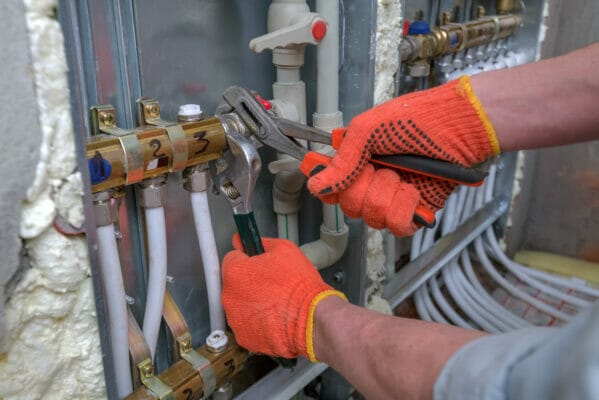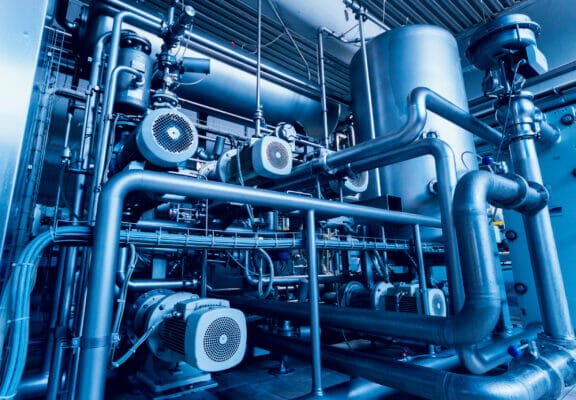Disclaimer: This post may contain affiliate links, meaning we get a small commission if you make a purchase through our links, at no cost to you. For more information, please visit our Disclaimer Page.
A journeyman pipefitter is a licensed tradesperson skilled in pipefitting and has successfully completed an official apprenticeship program. So, journeyman pipefitters are considered authorized and competent to work in pipefitting as qualified employees.

You can earn the journeyman’s license once you have completed the required pipefitter training and apprenticeship to operate securely on any form of piping system in the home and business environment.
But note that a journeyman might not yet work as a self-employed master pipefitter.
Table of Contents
What Does a Journeyman Pipefitter Do?
A journeyman pipefitter can handle high- and low-pressure piping systems’ installation, repair, and maintenance.
They operate and fabricate different types of mechanical connections, notably piping for steam boilers, heated air, propellers, central heating, pneumatic cylinders, and virtually all systems that use pipes.
Besides, a journeyman pipefitter sets up and maintains pipe systems in different environments, including industrial, hospital, and nuclear power plants.
They work with welding torches and grinders and may need welding skills to ensure a perfect fit during installations.
As a journeyman pipefitter, you bend and shape pipes and install them in the system. You will need to be able to read blueprints.
That’s because journeyman pipefitters deal with pressured water, valves, heat, oils, gasoline, and other substances. They also cut and weld alloys.
What’s A Day Like for A Journeyman Pipefitter?
A journeyman pipefitter spends their day analyzing designs and constructing pipe systems. They use torches and specialized equipment to pound, slice, bend, connect, solder tubes as per the requirements.
Other responsibilities include checking industrial facility water infrastructure and industrial plant systems.
The journeyman can also maintain annual air condition systems, and fix refrigeration equipment. They may also help in supervising pipefitter apprentices and helpers on site.
What Are the Differences Between Journeyman and Regular Pipefitter?
A regular pipefitter can work as a journeyman only after about 2-6 years working with an experienced (master) pipefitter.
Besides, a regular pipefitter can only work under direct supervision. Conversely, journeyman pipefitters are free to work independently.
That’s because they’ve proven they have the pipefitting experience and knowledge.
Do Journeymen Earn More Money Than a Normal Pipefitter?
Pipefitter salary increases with experience years. Hence, a journeyman earns more than a normal pipefitter. Apprentices can make more money on the job as they gain proficiency and skills.
For example, journeymen in union shops get raises by negotiating contracts with management.
Furthermore, journeyman pipefitters who have the necessary experience and education can apply for a master pipefitter license.
As a result, their earning potential will increase.
How Do You Become a Journeyman Pipefitter?
A person can become a journeyman pipefitter through supervised experience, education, and examination.
Typically, it would be best if you were at least 18 years old with a high school diploma or a GED certificate to be licensed as a journeyman fitter.
Also, proficiency in math, particularly mathematics associated with geometry and measurements, is essential.
By completing chemistry, mechanical drawing, and physics classes, the apprentice can also receive an associate degree while learning a skill in pipefitting. A 12-month diploma with supporting certifications provided as students master each level of training is also important.
You should also acquire a pipefitting apprenticeship four-year registered apprenticeship program. Most programs require about 576 hours of classroom education.
Outside the classroom, you need to gain hands-on experience working under the supervision of a master pipefitter.
Typically, you’ll need proof of 3,850 hours of residential and 3,850 hours of commercial experience as an apprentice or journeyman pipefitter.
You can get apprenticeships from organizations, businesses, and pipefitting unions. For instance, the United Association offers five-year union pipefitting apprenticeships.
Once you’re done with the training, you can take the journeyman pipefitter exam to allow you to work without supervision.
What Skills Are Required to Excel in A Career in Journeyman Pipefitter?
Problem-solving, rational reflection and critical-thinking skills are vital when troubleshooting and finding a practical solution.
Besides, the capacity to read schematics enables you to precisely understand where to lay piping and the quantity or requirement of pipes for installation.
Moreover, comprehending and analyzing schematics helps prevent potential leakage, piping difficulties, or safety hazards.
Note that physical strength is also essential in carrying and transporting long pipes and heavy tools.
Is The Process Of Becoming A Journeyman Pipefitter Hard?
The path to becoming a journeyman pipefitter can be difficult and time-consuming. But it’s worth it as you’ll be earning a decent salary with a stable career doing what you love.
However, note that journeyman pipefitters face dangerous scenarios at work. This may result in injuries such as ladder falls, burns from steam pipes, and cuts from sharp tools.
Does A Journeyman Pipefitter Require Licensing?
A license is required to work independently as a journeyman pipefitter. Although state regulations vary, many state licensing boards need a permit to operate on various plumbing systems.
So, once you complete your on-the-job and classroom training and other courses, you should apply to be certified as a journeyman pipefitter.
You should submit the necessary documentation, complete the application, and pay the licensing fee. In some states, you might need to sit and pass a licensing exam.
Moreover, a separate license might be necessary to work on gas lines and metal lines, while some employers require a journeyman pipefitter to have a license to drive trucks large enough to transport the pipes to the required job sites.
Does A Journeyman Pipefitter Require ASME Training and OSHA 30 Courses?
In many states, a journeyman pipefitter should complete ASME training and OSHA courses.
The American Society of Mechanical Engineers (ASME) designs codes and standards for pneumatics, pressure valves, boilers, and other equipment pipefitters work with. The regulations ensure that equipment will function safely.
Hence, pipefitters should learn these codes and prove their proficiency on ASME codes to qualify as journeymen.
Moreover, other states require journeyman pipefitters to complete the OSHA (Occupational Safety and Health Administration) 30 course.
The course comprises 30 hours of classroom instruction about safety practices for industrial workplaces.
Once you complete the course, you’ll receive a certificate that can aid in acquiring the journeyman licensing.

What Industries Does a Journeyman Pipefitter Work In?
Typically, journeyman pipefitters work in an industrial environment, including power plants, office buildings, and factories. They might also work outside in harsh temperatures or oceans and seas.
Working hours may be irregular and prolonged and require an emergency response to inspect and repair malfunctioning systems long after working hours.
What’s Difference Between a Journeyman Pipefitter and Master Pipefitter?
A journeyman pipefitter can take up employment with a licensed pipefitter contract company and work independently. But a journeyman’s license is limited to that of the master pipefitter.
So, for instance, journeymen aren’t allowed to start their pipefitting companies, but after a few years, they can take the master’s pipefitter exam to become business owners.
What’s The Job Growth Trend for Journeyman Pipefitters?
According to the Bureau Statistics of Labor, the demand for plumbers, steamfitters, and pipefitters is projected to grow by 14 percent, resulting in the creation of approximately 66,100 jobs annually by 2028.
New construction building-code system requirements are projected to fuel the growth trend for journeyman pipefitters.
Furthermore, even during economic downturns, old structures and factories should be repaired.
